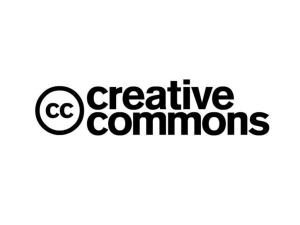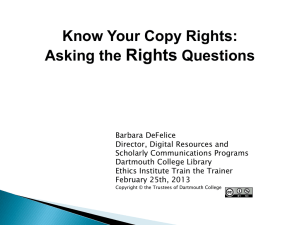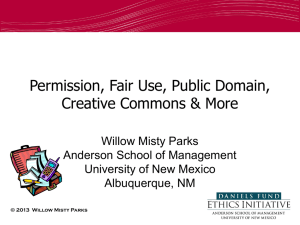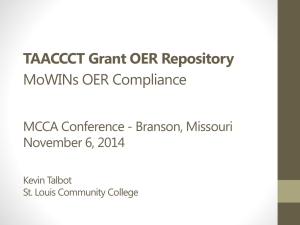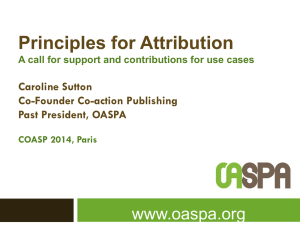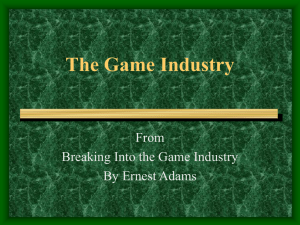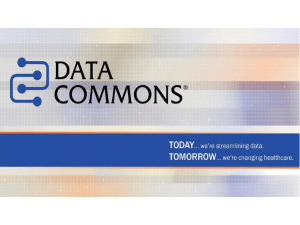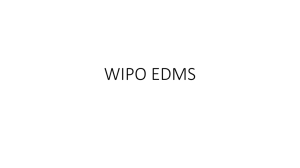Intellectual Property Section 1 Copyright
advertisement
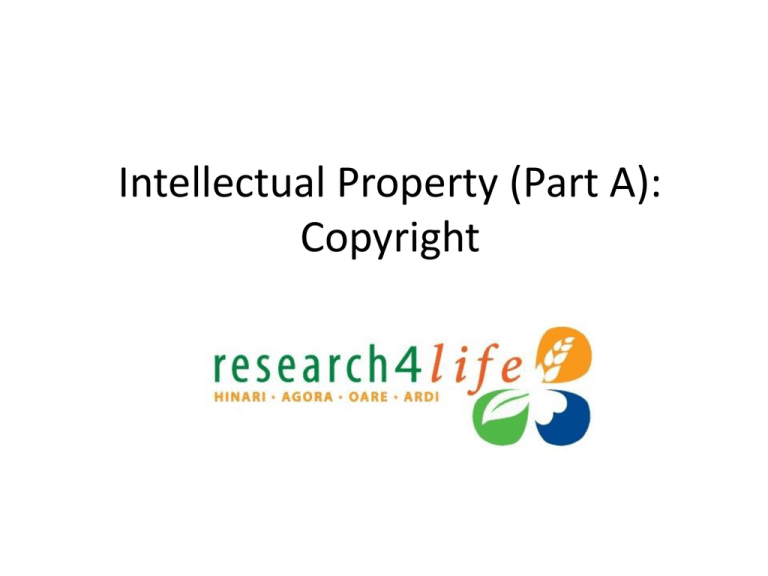
Intellectual Property (Part A): Copyright Key Topics • • • • • • Part A Definitions & Background Copyright & Creative Commons Author Rights & Open Access Part B Plagiarism – background, guidelines and examples Current Research Environment ‘Academic/research institutions reward those with the longest CVs and the most publications. Under pressure to generate voluminous output, scientists often fall prey to double publishing, self plagiarism, and submitting the minimal publishable unit. Are these ethical gray areas, or true transgressions?’ Executive Editor Clin Invest. 2008 118(7): 2368 Intellectual property (IP) refers to creations of the mind: inventions, literary and artistic works, and symbols, names, images, and designs used in commerce. World Intellectual Property Organization http://www.wipo.int/about-ip/en/ (accessed 14 Mar 2011) Intellectual Property is divided into two categories: • Industrial property, which includes inventions (patents), trademarks, industrial designs, and geographic indications of source • Copyright, which includes literary and artistic works such as novels, poems and plays, films, musical works, artistic works such as drawings, paintings, photographs and sculptures, and architectural designs. Rights related to copyright include those of performing artists in their performances, producers of phonograms in their recordings, and those of broadcasters in their radio and television programs World Intellectual Property Organization http://www.wipo.int/about-ip/en/ (accessed 14 Mar 2011) Any or all of the copyright owner’s exclusive rights or any subdivision of those rights may be transferred, but the transfer of exclusive rights is not valid unless that transfer is in writing and signed by the owner of the rights conveyed or such owner’s duly authorized agent. Transfer of a right on a nonexclusive basis does not require a written agreement. United States Copyright Office http://www.copyright.gov/circs/circ01.pdf (accessed 2 November 2013) Before an article is published in a journal, or before a contribution to an academic textbook is published, author and publisher enter into a publishing agreement which often entails an assignment of copyright or exclusive dissemination rights. An assignment transfers the copyright from author to publisher outright, while a licence merely transfers circumscribed or limited rights to the publisher. In general, publishers in the field of science, technology and medicine (STM) prefer assignments over licences. International Association of Scientific, Technical & Medical Publishers http://www.stm-assoc.org/2007_10_01_Copyright_Assignment_Benefits.pdf (accessed 2 November 2013) Open access journals will either let authors retain copyright or ask authors to transfer copyright to the publisher. In either case, the copyright holder will consent to open access for the published work. When the publisher holds the copyright, it will consent to open access directly. When authors hold the copyright, they will insure open access by signing a license to the publisher authorizing open access. Authors of preprints hold the copyright to them and may post them to open access repositories with no copyright problems whatever. EIFL Electronic Information for Libraries (EIFL) http://www.eifl.net/faq/openaccess-compatible-copyright (accessed 2 November 2013) Educational fair use guidelines have been established to provide “greater certainty and protection” for teachers and... apply to material used in educational institutions and for educational purposes: • noncommercial instruction or curriculum-based teaching by educators to students at nonprofit educational institutions • planned noncommercial study or investigation directed toward making a contribution to a field of knowledge, or • presentation of research findings at noncommercial peer conferences, workshops, or seminars Stanford University Libraries: Copyright and Fair Use http://fairuse.stanford.edu/overview/academic-and-educationalpermissions/non-coursepack/ (accessed 2 November 2013) Glossary - Copyright • attribution – identifying the source of a work / giving credit • copyright – a form of legal protection given to the creators of "original works of authorship“ • copyright infringement - a violation of the exclusive rights of a copyright holder, such as copying, distributing, or performing the copyright owner's work without permission • derivative work – a new work that translates or transforms one or more original copyrighted works • fair use - permits a second user to copy part or all of a copyrighted work without permission from the copyright holder • intellectual property – creations of the mind • license – permission to use a creative work Additional Resources • United States Copyright Office: Copyright Basics http://www.copyright.gov/circs/circ01.pdf • United States Copyright Office: Reproduction of Copyrighted Works by Educators and Librarians http://www.copyright.gov/circs/circ21.pdf • Stanford University Libraries: Copyright and Fair Use http://fairuse.stanford.edu/ Copyright & R4L E-journals • Electronic journals are protected by copyright law in the same way as print journals • Their use is subject to the terms of a license agreed between the institution and the publisher which permits certain activities and forbids others • For the Research4Life programs, users can copy up to 15% of a journal issue, distribute to colleagues within the institution and use for educational purposes • Users cannot distribute copies to individuals outside the institution, change the content, load material on a publically accessible server or use for profit Copyright & Creative Commons: Author rights vs. Publisher requirements Basic facts authors need to know • Copyright protection is automatic once a work is fixed in a tangible medium • Joint authors each have full and equal copyrights • Copyright can be transferred only in writing • Not all rights have to be given away – author/copyright rights can be broken apart Author rights • Copyright is a “bundle” of rights and these exclusive rights include: – reproduce the work in copies – distribute copies of the work – publicly display or perform – make derivatives, adaptations, translations – authorize others to use any of these rights Author options • Transfer all rights to publisher (traditional) – Author no longer has control over work • Licensing (Creative Commons) – Enables the copyright holder, whether author or publisher, to license partial rights to other parties • Addenda (SPARC, Science Commons, CIC) – Added to copyright transfer agreements and refer the desired rights to the author. – Leads to negotiations between author and publisher Author needs: anticipate future uses of your work • • • • • • • • Share work with colleagues Distribute at conferences Self-publish (personal website, CM, CV) Link to the full-text from your website Submit to an open access repository Republish; adaptation; translation Use in class Use in coursepacks Publisher requirements: • Publishers want traditional contracts –Reproduction –Distribution –Derivatives –Editorial control –Digital archiving –Format changes If…then – basics of reuse • By the author – If full rights retained, then limitless (within the law.) – If some rights retained, then within limits of negotiated rights. – If no rights retained, then fair use or permission. • By others – If published open access, then freely accessible. – If published under a Creative Commons license, then within limits defined by the license. – If published traditionally, then fair use or permission. Authors - Where to begin? • • • • • Know what rights you want to retain. Identify a publisher that allows authors to retain most rights. READ THE PUBLISHERS AGREEMENT! Include an Addenda to the publisher agreement. Opt to publish in an Open Access journal and use various licensing resources, such as Creative Commons. Examples: • Science Commons: Scholars Addendum Engine • SPARC Author Addendum • University of Michigan Authors Addendum • MIT Faculty Open Access Policy Creative Commons (new licensing model) What it is and how it benefits teaching and research A solution to a copyright problem • Copyright is automatic – No opt in – No opt out • Copyright is restrictive – Rights belong ONLY to the author – Can be transferred or shared – But for mass distribution online? How? Licenses and Marks • The license is a contract – How do we transfer copyright rights? – How do we give or get permission? – Creative Commons is a set of licenses (a type of contract) with standard terms, for permission to copy/share/modify copyrighted work • The mark is a standard symbol that content consumers can recognize and trust The Licenses: Four Conditions Attribution – the license lets others distribute, remix, tweak and build upon the work, even commercially as long as credit is given to the original creation (most accommodating/maximum dissemination) Noncommercial – this license allows others to remix, tweak and build upon the work non-commercially; new work must acknowledge and be non-commercial No Derivative Works – this license allows for redistribution, commercial and non-commercial, as long as it is passed along unchanged and in whole with credit to the creator. Share Alike – this license lets others remix, tweak or build upon original work (even for commercial use) as long as there is credit and it is licensed as a new creation under same terms (used for open source software licenses). Six Combinations Attribution Attribution – Share Alike Attribution – No Derivatives Attribution – Noncommercial Attribution – Noncommercial – Share Alike Attribution – Noncommercial – No Derivatives http://creativecommons.org/licenses/ (Accessed 14 March 2011) The Benefits: Using CC-licensed works • Teaching – In classroom face-to-face – Online course development – Course materials • Creative works – No-risk use of images, music, text, film, etc. to inspire/build upon/mashup into new creations • Research – Same as above Licensing your own works • Creative Commons web site http://www.creativecommons.org/ • Choose a license based on what you want to allow users to do • Registration process – there is none! • Display the mark and link to the license text Outcomes • Creative Commons licensing benefits everyone – Content providers – Content consumers – Teachers/researchers • Authors can retain rights (to copy, share, modify, etc.) in publishing contracts Resources - International • WIPO: World Intellectual Property Organization http://www.wipo.int/portal/index.html.en • Includes sections on: – Copyright and Related Rights http://www.wipo.int/copyright/en/ – WIPO Intellectual Property Handbook: Policy, Law and Use http://www.wipo.int/about-ip/en/iprm/ – WIPO Administrative Treaties http://www.wipo.int/treaties/en/ – Frequently Asked Questions http://www.wipo.int/patentscope/en/patents_faq.html Copyright for Librarians • An online open curriculum on copyright law developed by Harvard’s Berkman Center for Internet and Society in 2012 • Provides librarians in developing and transition countries information concerning copyright law • Includes information on copyright theory, public domain, how copyright law is interpreted and shaped • Contains a glossary of copyright terms • Available multiple languages www.eifl.net/copyright-for-librarians • Is a downloadable PDF bit.ly/UpYrcQ
